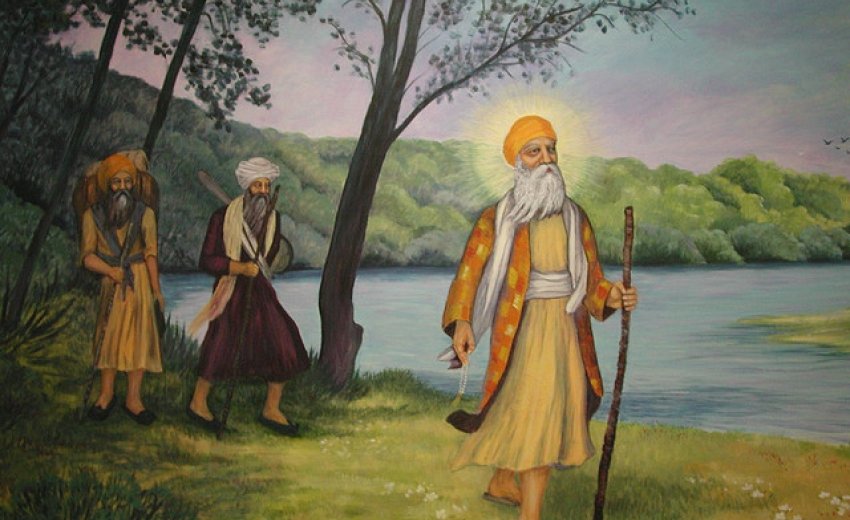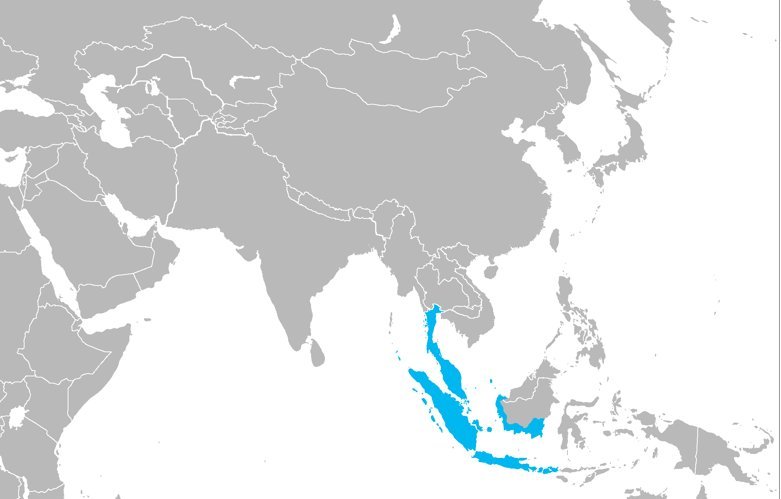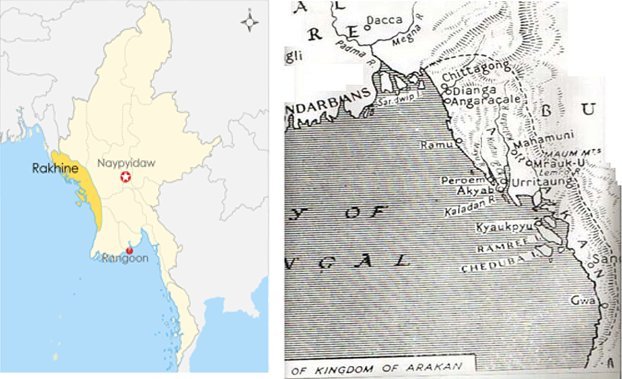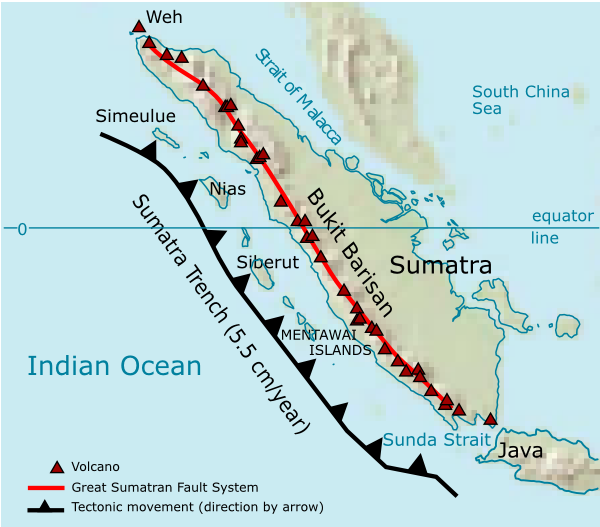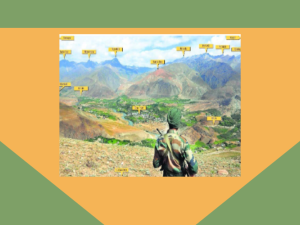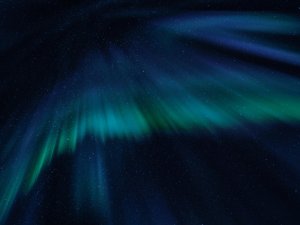|
Guru Nanak Visits Empire of 100 Islands Bhai Gurdas's Var is the earliest account of Guru Nanak's travels. He says: "Winning the fort (religious centre) of Baghdad he won over Mecca and Medina. He exposed the false philosophies of the Sidhas. ….He won over nine regions of the earth and spread his message of True Name of God." The reason of travels of Guru Nanak has been described by Bhai Gurdas in his first 'var' (verse) to redeem the 'the four lands and nine regions' and to convey the True message of the Lord.[1] Janamsakhi Bhai Bala (JS BB) edited by Dr Surinder Singh Kohli mentions that Guru Nanak visited Kings Sudhar Sain, Madhur Bain and Kawal Nain. "Guru Nanak bestowed the kingdom of 100 islands in 3 continents to Sudhar Sain on the recommendation of Inder Sain. These islands were ruled by 18 kings. (p.176) This Empire was earlier ruled by Kawal Nain son of Sur Sidh Misr/Brahman by caste. (p.198) [2]. Guru Nanak travelled for seven months and thirteen days to Swanrnpur, the capital of the kingdom of Kawal Nain which could be seen from 4 cosa from sea. The empire of Kawal Nainwas spread in 7700 jojan. It had 18 vessel states in 3 continents ruled by 17 kings under him. These were: (a). Madhurbain (b). Sudharsain (c).Naga Paras Ram (d) Sukh Sagar (e). Raja Atika Ghatika (f). Sukhchain (g). Budh Bibek Balka (h). Asrapnah (j). Sudh Sobhalka (k). Sagar Sain (l). Raja Nain Jot (m). Bir Bain (n).Raja BalSanghar (o) Lal Chain (p). Raja Turtrang (q). Rai Ain (r) Raja Magan Rai (s) Kawal Nain(JS BB p.166, 178, pp.192-198) [3] The ruler of 100 islands is not found mentioned in any of the resource materials. However Nagarakertagama (Desawarñana) claimed for Majapahit an empire of 98 tributaries, stretching from Sumatra to New Guinea….. Majapahit fleets periodically visited many parts of the archipelago to obtain formal submission, or that the splendour of the Majapahit court led many regional rulers to send it tribute, in much the same way as they sent tribute to China, without any intention of submitting to orders from eastern Java. The trading power of Majapahit gave it a powerful sanction against defiant rulers. The eastern Java kingdom established especially close trading links with pepper suppliers in Sumatra and with other spice-producing regions in eastern Indonesia. It is probably best, therefore, to assess Majapahit's claims of empire as representing real authority, with the proviso that such authority never gave Majapahit significant administrative power outside Java, Bali and Madura.[4] Majaapahit was an Indianized kingdom based in eastern Java from 1293 to around 1527. Its greatest ruler was Hayam Wuruk, whose reign from 1350 to 1389 marked the empire's peak, when it dominated other kingdoms in the southern Malay Peninsula, Borneo, Sumatra, Bali, Kalimantan and eastern Indonesia, and the Philippines [5]. Majapahit empire was the last of the major Hindu empires of the Malay archipelago andis considered one of the greatest states in Indonesian history. Majapahit society developed a high degree of sophistication in both commercial and artistic activities. its capital was inhabited by a cosmopolitan population among whom literature and art flourished. It had a thriving cash economy based on rice cultivation and trade which supported a wide variety of industries and professions. Around 1527 it succumbed to the Sultanate of Demak. [6] As per Janam Sakhi Bhai Bala: The king did not want his people to bow before him. The 17 kings bowed in front of him and accepted his sovereignty. But he did not go to any one himself. Whatever he said was done. Guru Nanak said, "It is time of everyone. All are God's Creation. They are as God's creation as I am. We are not going to sleep in his protection but we must see him. The king who has won over pride; I have placed Sudhar Sain over him. Let us see what God does." (JS BB, p.196). [7] There have been records to show that Guru Nanak visited China and the place 'Nanking' is named after Guru Nanak's name'.[8] In various Janamsakhis also, the accounts are available describing Guru Nanak's journey to 'Brahampur', 'Silmila Dweep' [9] and numerous other Dvipas (Islands). His journey by sea is well explained by Dr. Kohli [10], which leaves no doubt that Guru Nanak visited the islands of 3 continents. Majapahit kingdom thus fits into the explanation of Bhai Bala Janamsakhi hence discussed in detail further. The Majapahit Empire was based in eastern Java and ruled much of the Southern Malay, Borneo, Sumatra, and Bali from about 1293 to around 1527. The Majapahit was the last of the great Hindu empires of the Malay Archipelago. The powerful Hindu kingdom, Majapahit, emerged in the 13th century and united much of what is now modern Indonesia. This Hindu-Buddhist state emerged as a trading Empire by the end of the 13th century and gained control over much of the archipelago, including Sumatra, Borneo, Sulawesi, Maluku, Sumbawa, Lombok, and Timor. Its territorial expansion was credited to its significant naval power and, to some extent, to Gadjah Mada, who was the military commander of the kingdom from 1336. Majapahit Kingdom was the last great Hindu-Buddhist Kingdom of Indonesia, whose influence started to decline in the late 14th century and early 15th centuries. The Kingdom finally collapsed at the beginning of the 16th century. It is sometimes seen as establishing a precedent for the present political boundaries of the Republic of Indonesia (Ricklefs 1993: 19).[11] In the 13th century the Hindu Javanese kingdom known as Majapahit spread across South East Asia eclipsing the previous Srivijaya empire. By 1377 the Majapahit soldiers had taken control of the last stronghold in Sumatra, the Minangkabau capital Palembang. They fought off the rebellion and could now control the gold trade route which gave so much power to the Minangkabau kingdom.
Although the Majapahit rulers extended their power over other islands and destroyed neighboring kingdoms, their focus seems to have been on controlling and gaining a larger share of the commercial trade that passed through the archipelago. During the reign of Hayam Wuruk (1350-1389) there were 12 provinces of Majapahit, administered by king's close relatives. When Majapahit entered the imperial phase during the administration of Gajah Mada, several overseas vassal states were included within the Majapahit sphere of influence, as the result the new larger territorial concept was defined. The model of political formations and power diffusion from its core in Majapahit capital city that radiates through its overseas possessions was later identified by historians as "mandala" model. The term mandala derived from Sanskrit "circle" to explain the typical ancient Southeast Asian polity that was defined by its centre rather than its boundaries, and it could be composed of numerous other tributary polities without undergoing administrative integration.[12] The territories within Majapahit Mandala sphere of influence were those categorized as Mancanegara and Nusantara. These areas usually had their own indigenous rulers, enjoyed substantial autonomy and had their own political institution intact without further integration into Majapahit administration. The same mandala model also applied to previous empires; Srivijaya and Angkor and also Majapahit's neighboring mandalas; Ayutthaya (Ayudhya) and Champa. Majapahit power began to decline with a war over succession that started in 1401 and went on for four years. Majapahit found itself unable to control the rising power of the Sultanate of Malacca. Dates for the end of the Majapahit Empire range from 1478 to 1527. A large number of courtiers, artisans, priests, and members of the royalty moved east to the island of Bali at the end of Majapahit's existence, where they remained isolated. The king was the paramount ruler, as the chakarvartin he was considered as the universal ruler and believed to be the living god on earth. The king held the highest political authority and legitimacy. This fits into the description of Kawal Nain's kingdom and his administration system as explained in Janamsakhi Bhai Bala.
Some of the important states under Majapahit were Sumatra, Borneo, Sulawesi, Maluku, Sumbawa, Lombok, and Timor. Other states associated with the kingdom included Sunda, Malay, and Burma. Majapahit dominance declined with the spread of Islam to Malacca in 1402. Although the Majapahit royal family stabilized itself in 1486, warfare broke out with the Muslim state of Demak and the dynasty, then ruling only a portion of eastern Java, ended in the 1520s or 1530s. Bhatara Prabhu Girindrawardhana Dyah Ranawijaya, was the last known king of Majapahit, possibly ruling until around 1520, when the capital was .0finally overrun by the forces of Demak. Little of the Majapahit Empire's former glory still stands in East Java, however, with the exception of temple ruins and some archeological discoveries. Some modern ethnic groups of interior Sumatra claim affinity with medieval Javanese empires. The highland Rejangs of Bengkulu Province claim their culture derived directly from Majapahit. The Rejangs' oral history relates that a major change in their customary laws occurred when four `princes' (pangeran) of Majapahit, after losing a dispute at court, fled to the hinterland in search of territory to rule. The four princes offered the Rejang people what they knew best: government. [13] According to Janam Sakhi Bhai Bala [14] details of Guru Nanak's visit to various areas ruled by Kawal Nain which he passed on to Sudhar Sain are as under: 1. Bisiar Des on sea shore travelling for 15 days 15 nights and meeting Jhanda Badhi, Sudhar Sain and Inder Sain. (JS Bhai Bala pp. 164, 168-176, pp. 156-158, p.165-166, pp. 168-177) 2. Asrapnah, Bisiar Des to Silmila Dvipa visiting the kingdom of Madhurbain at Brahmpur travelling by boat/ship for 6 months. JS BB pp. 177-180 3. Visiting Jambu Dvipa travelling by boat/ship for 27 days and 27 nights and won over Devloot and Devdoot. He stayed with them at Deoridhar for nine months. JD BB pp.180-183 4. Going to Parasnama travelling for three months from Jambu Dvipa and meeting King Teekhtain and visiting ape like men. (JS BB pp. 183-184) 5. Visiting Mecca, Medina, Baghdad (JS BB pp.184-185) 6. Travelled for seven months and thirteen days to Swanrnpur, the kingdom of Kawal Nain son of Sursi Misr/Brahman by caste saw a city visible from 4 kos. Kigdom in 7700 jojan.Following 17 kings are under him: (a). Madhurbain (b). Sudharsain (c).Naga Paras Ram (d) Sukh Sagar (e). Raja Atika Ghatika (f). Sukhchain (g). Budh Bibek Balka (h). Asrapnah (j). Sudh Sobhalka (k). Sagar Sain (l). Raja Nain Jot (m). Bir Bain (n).Raja BalSanghar (o) Lal Chain (p). Raja Turtrang (q). Rai Ain (r) Raja Magan Rai (JS BB p.166, pp.192-198) Puratan Janamsakhi edited by Shamsher Singh Ashok [15] mentions Guru Nanak;s visit to Bisiar Des meeting Jhanda Badhi (Puratan JS Shamsher Singh Ashok, p. 66) Blessing to Badhi (p.87) The names quoted in Janamsakhis have been discussed by various researchers as under; (a) Both Dr. Trilochan Singh and Dr. Surinder Singh Kohli agree that Burma is recorded as Brahampur, and Swaranpur was actually Sondeep and part of Burma. However the old chronicles record Swarnpur as Sumatra. (b) Atak-Ghatk is a modified name of Chittagaon/Chittaging which was originally known as Chitta-Chatoka[16]. A Gurdwara called Gurdwara Sikh Temple was constructed in the Chak bazar of the town. Bhai Mohan Singh, a poor Khatri of Patna Sahib who rose to be a diwan (Revenue Minister) of Nawab 'Ali Vardi Khan' of Bengal from 1740 to 1756 donated some property to the Gurdwara, which remained under the control of mahants. Later a Management Committee was formed under the orders of District Judge. In 1972, when Capt Bhag Singh alongwith a deputation visited the Gurdwara, Sri Satish Chander Roy was the President and Shri S.K. Barman was the secretary of the Managing Committee.[17] (c) Silmila dweep has been identified as Malaya Peninsula and includes, Siam. Annam, Cambodia, Jawa, Sumatra, Bali and Borneo'[18]. (d) Sudharsain is stated to be a powerful king of Chittagaon and Sondweep'[19]. (e) Dr. Kohli mentions, "It is said that there was a "Charan Padka" (the impression of the holy feet of the Guru) in Vat Sarkate (Temple) in Bangkok (Siam-Thailand). He is understood to have washed his hair at this place. He washeld in profound veneration like Lord Buddha, therefore, the annual function at the temple is held on Kartik Purnima. Another temple in Bangkok is known as Trei Mitter (temple of three friends) is supposed to have been built in memory of the Guru and his two companions Bala and Mardana. It is also probable that the Guru visited Ayodhya, also in Thailand, though the Ayodhya Chronicles did not mention Guru Nanak's visit to Thailand. [20]. (f) He further mentions. "If even the Guru touched China and Japan by this sea journey, we can assume that the Guru went to Peking and Nanking at this time. He was received respectfully by King of China and the King and the people of China were so much impressed by the Guru that the city of Nanking was named in his honour'[21]. (g) Gyani Lal Singh Sangrur also records in his account that Guru Nanak visited Assam, Kamakhia in Kamrup, Cachar, Khasi Hills, Manipur, Lushai areas of Burma, Syllhet, Ajmer Ganj, Karim Ganj and Ghargaon in Bangladesh, Rangoon and Mandley in Burma, Salmala Dvipa, Palpasare, Brahmpur, Chandpur, Swarnpur, ratanKhali, Faridpur, Kasabpur and Nanking and Peking in China. He also records, 'At many places in China, Guru Nanak's idol is worshipped even now and he is remembered by the name of "Baba Bhusa" (Fusang). Due to lack of missionaries, places connected with the Guru could not be preserved. Guru Nanak having discussions with Lama-Gurus in China blessed them with True Name. Many Jains and Buddhists became followers of Sikh religion.'[22]. (h) There are places named Nanking (Zhuangsu province), Nantong (Jiangsu Province) Nanjang (Henang Province), Nayang (Jianxi Province) and Nanping (Fujian Province) in China,[23] which similarly would have been named on Guru's Name. (j) Guru Nanak's travels to Singapore are also recorded in the form of a standing monument at Singapore'[24]. (k) Giani Gyan Singh in Twareekh Guru Khalsa, Guru 1 Part1, pp. mentions of Parsnama the city of Teekh Tain in Assam, Jhanda Badhi and Sudhar Sain as king of Cachar Manipur with capital at Aseemphal. From Cachar Manipur he went to Salmala Dvipa and stayed in Brahmpur with the king Maduhr Bain and then visited Kanwal Nain's place Swaranpur [25] Since Majapahit and its 98 islands turn out to be the main points of Guru Nanak's journey, the general route of his travel in these islands could be as follows: Starting from Bengal he met Sudharsain in Chittagon or Sondeep, visiting Devloot in Burma area enroute to Malay Peninsula Dvipa, meeting Madhurbain in Malay Peninsula, meeting Kawal Nain in Swarnpur in Indonesia (Java-Sumtra), meeting Teekhtain in remote island around Australia or American continent, Guru Nanak returned to Bengal for onward journey. Describing the area above, Janamsakhi Bhai Bala mentions 'When Mardana, the companion of the Guru expressed his desire to see all the seven dvipas the Guru said, "The great Jambu Dvipa is spread over one lakh yojan and lies in the middle of the other dvipas. The great mountain Sumeru lies within it. You have already seen the nine regions of this dvipa and one of these regions is Bharata Varsha. I cannot refuse to show you the other dvipas, therefore, let us go". Then the Guru started on this great journey. An ocean, one lakh yojan in length was crossed within a short period. The Guru reached Plaksha dweep with his companions. This dvipa was named after white Plaksha (or Pakhar) tree which was found is abundance in the region. The word Plaksha in Sanskrit means white. The people in this region were white and lustrous and lived a comfortable life like gods. They lived up to one thousand years. This dvipa was divided into seven parts and had seven rivers. Several people of the dvipa gathered around the Guru considering him a holy man from another dvipa and presented fruits of the area. The Guru asked them about the general condition of life in their dvipa. They said, "We have all comforts of life, but we have certain vices which create troubles. Jealousy is created on seeing the superiors; ego is created on seeing inferiors and enmity on seeing the equals. If these vices are shed away, there will be bliss forever. Kindly suggest some remedy for these ills". The Guru said, "There is light of God within everybody and there is none without Him. If you think in this way, the inequality will cease. There will be no trouble. Remember the name of the Lord. Join the holy congregation as brothers and pray". The people of the Dvipa became his followers. After staying there for several days, the Guru proceeded to the next Dvipa after crossing the Plaksha Dvipa spread over two lakh yojans. There was an ocean of sugarcane juice, one lakh yojans in length which was crossed by the Guru and his companions. They remained thirsty throughout this journey. They then entered the next Dvipas i.e., Salmalaadvipa. This dvipa derived its name from Salmali (Simmal) or silk-cotton tree. The Guru visited the town in this Dvipa. The people and the king received him with great respect. The Guru initiated the king into the worship of true Lord's name and the subject into His discipline'5. Details as given in Janamsakhi Bhai Bala are as follows: 'There is a foreign country named Asrapan under a king. Guru Nanak started his journey to the place. There is seat of Jhanda Badhi over there. They moved to Bisihar Desh which is on an island in the ocean......They moved ahead.....It was a journey for fifteen days and nights. All of them survived on air. Thereafter they reached Bisihar Desh, where Sudhar Sain was the king'6. Guru Nanak blessed Jhanda Badhi and Inder Sain in Bisihar Desh. Jhanda Badhi a carpenter by trade, was appointed as preacher in the area. Inder Sain the nephew of the king established a great rapport with the Guru. The king Sudhar Sain was enlightened by Guru's teaching and became his life-long disciple. Janam Sakhi further records. Then King Sudhar Sain got the news of Guru Nanak's arrival. He said to his courtiers, "A saint has come to my city who has been accepted as Guru by Jhanda Badhi. Please bring him to me". Inder Sain proceeded to Guru Nanak and bowing before him gave whatever he had brought. He prayed to the Guru "Sire, the king is eagerly waiting for you. You must bless him". Guru Nanak then blessed him and sang a hymn in Raag Bilawal, 'Mite aandh agg gaya bikara, Aisa sahib (meet the great Lord, whom we love.) Guru Nanak blessed Sudhar Sain and bestowed upon him the kingdom of 100 islands. King Sudhar Sain then ruled hundred islands for hundred years. There were eighteen other kings over which he ruled. He ruled three continents on the name of Guru Nanak and became a great person ....Guru Nanak stayed with king Sudhar Sain and Jhanda Badhi for one month on the request of Inder Sain. While travelling through sea for thirty seven days & nights, they saw a city, named Deogandhar. Its ruler was Deoloot, who ruled 17 lakh gods. He was a cannibal. As he came to know of the three sitting outside his city, he ordered his soldiers to bring them for his food. When the soldiers came to arrest them, they were unable to see the Guru and his companions. On the failure of soldiers, Devloot himself tried but he too was unable to see Guru. One of his minister, Devdoot, told Devloot, "The saint seems to be a person of great divine power. Let me go with no ill feeling and see what happens. If I too get blinded, you can do to me whatever you wish." The king Devloot agreed. As Devdoot went with pure heart he could see Guru Nanak and his companions. He asked Guru Nanak his name and the place he came from. Guru Nanak told him Amar Nagar as his residence and Nanak Nirankari as his name. The minister requested him to go to the city with him which Guru Nanak refused stating that he being a saint was happy wherever he was.....The minister told the complete details to the king Devloot, but the king remained adamant to hunt upon the Guru and said, "Let us all go. In case I am able to catch him, you will be punished". As they all went, all except the minister became blind again. Raja Devloot was repentant at his act. He prayed to Guru Nanak to excuse him. At this Guru Nanak asked him to open his eyes. Astonishingly the king, on opening his eyes, found Guru Nanak in front of him. Guru Nanak then asked him to change his food habits, to stop cannibalism and to consider all men equal. He also asked him to follows king Sudharsain. He stayed there for nine months. This area of Devloot was probably Rakhine (Arakan). The term Rakhine is believed to have been derived from the Pali word Rakkhapura (Sanskrit Raksapura), meaning "Land of Ogres"
(Rakshas), possibly a pejorative referring to the original Negreto inhabitants. The Pali word "Rakkhapura" ("Rakkhita") means "land of the people of Rakhasa" (also Rakkha, Rakhaing). The reign Mrauk U as per Araknese chronicle Rakhine Razavin Thit (Sandamala Linkara Vol. 2 1931) was from 1429 to 1785 AD.The Marak U first kingdom started from 1429 AD and continued till 1531 AD. During the times of visit of Guru Nanak Salingathu ruled the kingdom from July 1494 to February 1502 followed by his sons Raza upto Novemeber 1513 and Gazapati upto January 1515, Saw O, brother of Salingathu from January 1515 to July 1515 and Thazta son of Dawlya from July 1515 to Aril 1521. Name Arakan for it was used in British colonial times and is believed to be a Purtuguese corruption of the word Rakhine that is still popularly used in English. Mrauk U was declared capital of the Arakanese kingdom in 1431. At its peak, Mrauk U controlled half of Bangladesh, modern day Rakhine State (Arakan) and the western part of Lower Burma. As the city grew, many pagodas and temples were built. Several of them remain, and these are the main attraction of Mrauk-U. From the 15th to 18th centuries, Mrauk U was the capital of a mighty Arakan kingdom, frequently visited by foreign traders (including Portuguese and Dutch), and this is reflected in the grandeur and scope of the structures dotted around its vicinity.[26][27][28] Mrauk-U went on to be a powerful kingdom in its own right between 15th and 17th centuries, including East Bengal between 1459 and 1666. Arakan was the only post-Pagan kingdom not to be annexed by the Toungoo dynasty of Burma. There from they proceeded to Malay Penisula (Silmilla Dvipa). They moved on vast stretch of waters of the sea as if they were moving on earth. It took six months for them to reach. When they reached Silmilla Dvipa, Guru Nanak's name was already well known. Everyone narrated how he bestowed upon Sudhar Sain the kingdom of three dvipas and how he made Jhanda Badhi a great saint. All three stayed in the garden of a city. Mardana desired to go to the city. In fact he was hungry and wanted to have some food from the city. Guru Nanak said, "The name of this city is Brahampur and is ruled by Madhur Bain." As they were discussing, Raja Madhur Bain turned up there hunting. He questioned them. When he found that they were accompanied by the saint who has been to Bisihar to bless Sudharsain with a kingdom, he was very much pleased. He gave out details of his kingdom and surrounding areas. He stated, "I am Madhur Bain, I am the king of this area and a Brahman by caste. Name of this city is Brahampur....There are eighteen kings in these three dvipas. They are Kaul Nain, Madhur Bain, Sudhar Sain, Sukhchain, Asrapan, Sagar Sain, Bir Nain, Lal Nain, Rai Sain, Sukh Sagar, Naga Paras Ram, Raja Atak-Ghatak, Sudhi Balka, Budh-Bibek-Balka, Raja Nam Jyoti, Raja Bali Sanghar, Raja Jur Jarang and Raja Madan Raja". Bala told him, 'Guru Nanak has blessed Sudhar Sain to rule over all of you. Raja Madhurbain invited Guru Nanak to city. Guru Nanak sang hymn in Raag Bilaval 'Ek bhandar ke jin sahib kichh dia, bhukh nang sabh cheenkar apna kar liya' (God his given me every thing by giving me the store of True Name. He has snatched hunger and nakedness and made me his own). Raja Madhurbain then became his disciple. Guru Nanak asked him to serve Sudharsain. All three stayed with Madhurbain for one month before departing. His next journey was to the capital of Majapahit for seven months and thirteen days. After reaching Suwaranpur (Sumatra), Guru Nanak and Bala sat outside the premises of the city while Mardana entered the city. Mardana found it to be the land of gold. On enquiry he found the name of the city to be Suwaranpur ruled by king Kaul Nain, son of Surat Singh. Every one could eat whatever he wanted, there was no check. Order of the king was that every visitor will be given free food of his choice. Every item including the balance and weights in use, were of gold. The person known as Dharam Singh gave Mardana whatever he desired and asked him to take some sweet for his companions. Mardana however took nothing. On return, he told all the details, about the city to Guru Nanak. Guru Nanak was happy that Mardana brought nothing. He told Mardana, "This is the city of Dharma. Hence, no one does any evil. Everyone is contented. They do not have Turks in this state. They do not know Turks or even the idol worshippers". Guru Nanak told him the limits of the kingdom to be equal to nine thousand seven hundred yojan. No other king had such a vast terriory in the world. Mardana visited the city for 7 consequent days. Eighth day, Dharam Singh asked him about his companions, as to why they did not come. Mardana said, "They are contented. They live on air". Dharam Singh gave Mardana 2.5 seer of sweets for him and 5 seers for Guru Nanak and Bala and reached alongwith Mardana to the location where they had stayed. Announcing his arrival with God's name, Dharam Singh presented the food. Guru Nanak refused to take it, stating, "Your king has done some wrong and he should be knowing what it was about." Dharam Singh was perplexed. He wanted to know what wrong his King had done but Guru Nanak refused to tell. Dharam Singh went to the king and stated what all happened. The king pondered over his entire past. Finding nothing wrong, he proceeded to Guru Nanak to clarify. Guru Nanak welcomed him and told him the details of his previous birth and the present life pointing out that he should not allow himself to be worshipped as he was not a God. The king fell at Guru's feet and begged for forgiveness. Guru Nanak asked him to serve Sudharsain and rule over the area as a Dharam-Raja as he has been doing so far. From Malaysia Guru Nanak's next journey to the capital of Kawal Nain which was in Sumatra also known as Suwarnpur. Sumatra was known in ancient times by the Sanskrit names of Swarnadwīpa ("Island of Gold") and Swarnabhūmi ("Land of Gold"), because of the gold deposits of the island's highland.[29] The first word mentioning the name of Sumatra was the name of Srivijiyan (king) Sumatrabhumi ("King of the land of Sumatra"), [30] who sent an envoy to China in 1017. One of the earliest known kingdoms was Kantoli, which flourished in the 5th century CE in southern Sumatra. Kantoli was replaced by the Empire of Srivijaya and then later by the King of Samudra. Srivijaya was a Buddhist monarchy centered in what is now Palembang. Late in the 14th century the name Sumatra became popular in was replaced reference to the kingdom of Samudra Pasai, which was a rising power until it by Sultanate of Aceh. Sultan Alauddin Shah of Aceh, on letters written in 1602 addressed to Queen Elizabeth I of England, referred to himself as "king of Aceh and Samudra".[31] The word itself is from Sanskrit "Samudra". [32]
The longest axis of the island runs approximately 1,790 km (1,110 mi) northwest-southeast, crossing the equator near the centre. At its widest point, the island spans 435 km (270 mi). The interior of the island is dominated by two geographical regions: the Barisan Mountains in the west and swampy plains in the east. To the southeast is Java, separated by the Sunda Trait. To the north is the Malay Peninsula, separated by the Strait of Malacca. To the east is Borneo, across the Karimata Strait. West of the island is the Indian Ocean. The backbone of the island is the Barisan Mountain chain, with the active volcano Mount Kerinci as the highest point at 3,805 m (12,467 ft), located at about the midpoint of the range. The volcanic activity of this region endowed the region with fertile land and beautiful sceneries, for instance around lake Toba. It also contains deposits of coal and gold. The volcanic activity stems from Sumatra's location on the Pacific Ring of Fire- which is also the reason why Sumatra has had some of the most powerful earthquakes ever recorded. Sumatra is not particularly densely populated, with just over 100 people per km2 - more than 50 million people in total. Because of its great extent, it is nonetheless the fourth [33] most populous island in the world. The most populous regions include most of North Sumatra and central highlands in West Sumatra, while the major urban centers are Medan and Palembang. His next visit was to Parasarama city. It was a three months journey. This area was ruled by king Teekhantain the king of apes. These apes used to live on wild-animal-hunt and jungle food. Seeing Guru Nanak and his companions, all except one ran. The one who stopped presented a tasty fruit which they enjoyed. Most probably it was beyond South East Asia, may be either in Microasia or Marshal Islands. Dr Kohli and Lala Singh Sangrur even mentioned that Guru Nanak visited Japan and Australia. This needs further research. Reference |

